.
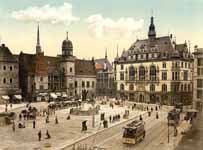


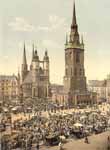

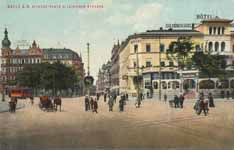
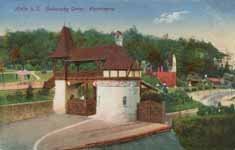
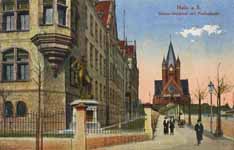

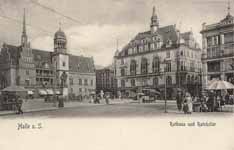
10, 11,
Halle
Halle is the largest city in the German state of Saxony-Anhalt. It is also called Halle an der Saale (literally Halle on the Saale river, and in some historic references simply Saale after the river) in order to distinguish it from the town of Halle in North Rhine-Westphalia. The current official name of the city is Halle (Saale).
Geography
Halle (Saale) is situated in the southern part of Sachsen-Anhalt, along the river Saale which drains the surrounding plains and the greater part of the neighbouring Free State of Thuringia located just to its south, and the Thuringian basin, northwards from the Thuringian Forest. Leipzig, one of the other major cities of eastern Germany, is only 35 km away.
History
Halle's early history is connected with harvesting of salt. The name Halle reflects early Celtic settlement given that 'halen' is the Brythnoic (Welsh/Breton) word for salt (cf. 'salann' in Irish). The name of the river Saale also contains the Germanic root for salt, and salt-harvesting has taken place in Halle since at least since the Bronze Age (2300-600 BC).
The town was first mentioned in 806. It became a part of the Archbishopric of Magdeburg in the 10th century and remained so until 1680, when Brandenburg-Prussia annexed it together with Magdeburg as the Duchy of Magdeburg, while it was also an important location for Martin Luther's Reformation with Albert of Mainz as his ecclesiastic counterpart. The Battle of Halle was fought between French and Prussian forces on 17 October 1806. The fighting moved from the covered bridges on the west side of the city, through the streets and market place, to the eastern suburbs. In 1815 Halle became part of the Prussian Province of Saxony.
During World War II, Birkhahn labor camp, a subcamp of Buchenwald was located in Halle, where prisoners from Poland, Czechoslovakia, the Soviet Union, France, Netherlands and other nations[2] were forced to work in the Siebel aircraft plants, making combat aircraft. The plant was later dismantled. In Ammendorf, a large factory owned by Orgacid GmbH produced mustard gas.
Near the end of World War II, there were two bombing raids carried out against the town: the first on 31 March 1945, the second a few days later. The first attack took place between the railway station and the center of the city and the second bombing was in the southern district. It killed over 1,000 inhabitants; 3,600 buildings were destroyed and many heavily damaged. Among them, the Market Church, St. George Church, the Old Town Hall, the City Theatre, historic buildings on Friars Road and on the Great stone street, and the city cemetery. On 17 April 1945 Halle was occupied by American troops, and the red tower was set on fire by artillery and destroyed. Also, the Market Church and the Church of St. George received more hits. The city however, did not sustain further damage because a planned aerial bombardment was canceled, after a former Commander of the First World War, Count Felix von Luckner and the city's Mayor negotiated the surrender of the city to the American army. In July, the Americans withdrew and the city was occupied by the Red Army.
After World War II, Halle served as the capital of the short-lived administrative region of Saxony-Anhalt, this was until 1952 when the East German government abolished its "Länder" (states). As a part of East Germany (until 1990), it functioned as the capital of the administrative district ("Bezirk") of Halle. When Saxony-Anhalt was re-established as a Bundesland, Magdeburg became the capital.
According to historic documents, the city of Halle has been a member of the Hanseatic League at least since 1281.
Main sights
The Marktkirche's four towers and the city's nearby Roter Turm (Red Tower) are a landmark symbol of the city. The two east-side Hausmannstürme (keeper's quarters) are connected by a bridge and on this bridge was the fire watch. The two west-side octagonal Blue Towers are so-named because of their dark blue slate roofing. The Red Tower was originally a campanile to the former St. Mary's Church.[3][4]
Giebichenstein Castle, first mentioned in 961, in the north of the city centre on a hill above the Saale river, with a museum in the upper castle and the Burg Giebichenstein University of Art and Design in the lower castle.
Moritzburg, a newer castle, was built between 1484 and 1503. It was the residence of the archbishops of Magdeburg, was destroyed in the Thirty Years' War, and has been a ruin afterwards for centuries. Partially reconstructed in 1901-1913, it is an Art Gallery today. The reconstruction was completed with the opening of new exposition rooms, designed by the Spanish architects Sobejano and Nieto, in 2010.
Neue Residenz (New Residence), an Early Renaissance Palace (1531–1537)
Market square with
Market Church St. Mary (Marktkirche), built in 1529–1554, using elements of two medieval churches, St. Gertrud Church dating back to the 11th Century and the older St. Mary Church from the 12th Century. The church has four steeples, two of them called Blue Towers, the other two Hausmannstürme with the tower-keepers dwelling. It owns as well the original death-mask of Martin Luther.
Roter Turm (Red Tower), originally built as campanile of the older St. Mary Church between 1418 and 1503, a landmark of Halle, forms with the steples of St. Mary Church the five towers marking the city’s silhouette.
Roland, originally (13th century) a wooden sculpture representing the urban liberty (after an uprising in the city, a cage was placed around it between 1481 and 1513, a reminder of the restrictions). Today’s sculpture is a sandstone replica made in 1719.
Marktschlösschen, Late Renaissance building, Gallery and Tourist Information
Monument to George Frideric Handel, 1859 by Hermann Heidel
Ratshof (Council’s Yard), built in 1928/29 as backyard building of the Old Town Hall (that was demolished in 1948/50 after the destructions in WWII, so the Ratshof is situated today directly at the market square).
Stadthaus, Neo-Renaissance building of 1891-1894
Yellow line, which runs over the market square, marking a geological fault line (Hallische Verwerfung).
Handel House, first mentioned in 1558, birthplace of George Frideric Handel, a museum since 1948
Old Market square with Donkey‘s Fountain (1906/13), referring to a local legend
Remains of the town fortifications: the Leipziger Turm (15th century) in the east and remains of the town wall in the south of the city centre.
Francke Foundations, baroque buildings (including Europe‘s largest surving half-timbered building) and historical collections
Stadtgottesacker, a Renaissance cemetery, laid out in 1557, in the style of an Italian camposanto
Saline Museum is dedicated to Halle’s salt-works and the corporation of salt workers (Halloren)
Cathedral (Dom), a steepleless building, was originally a church within a Dominican monastery (1271), converted into a cathedral by cardinal Albert of Hohenzollern. Since 1688, it has been the church of the Reformed parish.
Saint Maurice Church, Late Gothic building (1388–1511)
Saint Ulrich Church, Late Gothic church of the Servite Order (15th century), today used as concert-hall
Church of the former village of Böllberg (Romanesque, with Late Gothic painted wooden ceiling)
Numerous bourgeois town houses, including the Ackerbürgerhof (15th - 18th century with remains from the 12th century), Christian Wolff’s House (today City Museum) an Graseweg House (half-timbered building)
State Museum of Prehistory where the Nebra sky disk is exhibited
Volkspark (1906/07), former meeting house of the Social Democrats
Theatres:
Halle Opera House
Neues Theater
Thalia Theater, the only Theatre for Children in Saxony-Anhalt
Steintor Bühne
Parks and gardens:
Botanical Garden of the Martin-Luther University Halle-Wittenberg, founded in 1698 in the former gardens of the archbishops of Magdeburg, belonging to the Garden Dreams project
Reichardts Garden is an historic park, part of the Garden Dreams project. Laid out in 1794 by Johann Friedrich Reichardt (1752–1814) as an English garden, becoming the “accomodation of Romanticism”. It changed ownership several times and the city of Halle bought the park in 1903 to give the wider public access.
Peißnitz Island
Pestalozzi Park
Zoological Garden (Bergzoo), situated on the Reilsberg hill.
Galgenberge, location of the Gallows from the 14th to the end of the 18th Century
Klausberge, porphyry mountain, named after a chapel of the St. Nicholas brotherhood, panoramic view over the Saale Valley, Eichendorff‘s bench
Dölauer Heide forest, including Bischofs Wiese where 35 graves dating back at about 2500-2000 B.C., the Neolithic Period, are situated
Racecourse in the Passendorf Meadows
Halle-Neustadt, in the west of Halle, built in the 1960s as a socialist model city.
Halle Cycle
The towers on a 2002 German stamp, based on a painting by Lyonel Feininger
German-American expressionist painter Lyonel Feininger worked in Halle on an invitation by the city from 1929-1931. As one of eleven views of the city termed Halle Cycle, he painted in 1931 Die Türme über der Stadt (The towers above the city), which is now in the Museum Ludwig in Cologne.[5] This painting appeared on a 55 eurocent stamp on 5 December 2002 as a part of the series “Deutsche Malerei des 20. Jahrhunderts” (German painting of the 20th century).[6]
Industrial heritage
Salt, also known as White Gold, was extracted from four "Borns" (well-like structures). The four Borns/brine named Gutjahrbrunnen, Meteritzbrunnen, Deutscher Born and Hackeborn, were located around the Hallmarket (or "Under Market"), now a market square with a fountain, just across from the TV station, MDR. The brine was highly concentrated and boiled in Koten, simple structured houses made from reed and clay. Salters, who wore a unique uniform with eighteen silver buttons, were known as Halloren, and this name was later used for the chocolates in the shape of these buttons.
The Halloren-Werke, the oldest chocolate factory in Germany, was founded in 1804. Old documents are on display and a chocolate room can be visited at Delitzscher Street 70. The original "Halloren-Kugeln" are sold in a box of eighteen little pralines.
Within East Germany, Halle's chemical industry, now mainly shut down, was of great importance. The two main companies were Buna and Leuna, and Halle-Neustadt (Halle Newtown) was built in the 1960s to accommodate the employees of these two factories.
Science and culture
The University of Halle was founded here in 1694. It is now combined with the University of Wittenberg and is called the Martin Luther University of Halle-Wittenberg. The medical school there was founded by Friedrich Hoffmann. The university's botanical garden, the Botanische Garten der Martin-Luther-Universität Halle-Wittenberg, dates to 1698.
The famous Baroque composer George Friderich Handel was born in Halle in 1685, where he spent the first 17 years of his life. The house where he lived is now a museum and houses an exhibition about his life. To celebrate the composer, Halle has staged a Handel Festival since 1922, annually in June since 1952.
The Franckesche Stiftungen (Francke Foundations) are also home of the famous Stadtsingechor zu Halle, who was founded before year 1116 and is one of the oldest boys' choirs in the world.
The German Academy of Sciences Leopoldina is the oldest and one of the most respected scientific societies in Germany.
Halle accommodates Germany's oldest Evangelical Bible college, known as the Marien Bibliothek, with 27,000 titles.
In the past Halle was a centre of German Pietism and played an important role in establishing the Lutheran church in North America, when Henry Muhlenberg and others were sent as missionaries to Pennsylvania in the mid 18th century. Muhlenberg is now called the first Patriarch of the Lutheran Church in America. He and his son, Frederick Muhlenberg, who was the first Speaker of the United States House of Representatives, were graduates of Halle University.
The Silver Treasure of the Halloren is displayed occasionally at the Technical Museum Saline. It is a unique collection of silver and gold goblets dating back to 1266. The ancient craft of "Schausieden" (boiling of the brine) can be observed there too.
The Landesmuseum für Vorgeschichte houses the Nebra sky disk, a significant (though unproven) Bronze-age find with astrological significance.
Halle Zoo contributes to the EAZA breeding programme, in particular for the Angolan Lion and the Malaysian Tiger. Halle is also known for its thriving coypu (or nutria) population, which is native to South America.
With writers as Heine, Eichendorff, Schleiermacher, Tieck and Novalis the town was a vibrant scene of the German Romanticism. Also Johann Wolfgang von Goethe was a regular guest at the house of his close friend Johann Friedrich Reichardt.
Transport history
Ludwig Wucherer made Halle an important rail hub in central Germany. In 1840 he opened the Magdeburg-Halle-Leipzig line, completing a connection between Magdeburg and Dresden. In 1841–1860, other lines to Erfurt, Kassel and Berlin followed.
Since 1891 Halle has had the first large electrical inner-city tram line in the world.[7] See also Halle (Saale) Hauptbahnhof, the main railway station.
Notable residents
Early Baroque composer and organist Samuel Scheidt (1587–1654) was both born and spent the majority of his life and career in Halle.
Baroque composer Georg Friedrich Händel was born in Halle on 23 February 1685, and stayed for 17 years.
Georg Cantor worked as a professor at the university of Halle.
Dorothea Christiane Erxleben of Quedlinburg (1715–1762) made her Doctor of Medicine in 1754 at the Medical Department of Martin Luther University (MLU).
August Hermann Francke (1663–1727), Lutheran Pietist theologian at the University of Halle and founder of the internationally renowned Halle Orphan House complex .
Johann Friedrich Reichardt was a composer, writer and music critic who lived in Halle. He was a close friend of Johann Wolfgang von Goethe.
Ludwig Wucherer (1790–1861) was elected Councillor.
Georg Listing (born 1987) bassist from the Magdeburg-based band, Tokio Hotel.
George Müller (1805–1898), coordinator of orphanages in Bristol, England.
Lyonel Feininger Painter who created several famous images in Halle, including Der Dom in Halle.
Reinhard Heydrich, one of the leading Nazis in World War II, was born in the town. Heydrich was assassinated by Czech partisans in Prague in 1942.
Hans-Dietrich Genscher, a former Vice Chancellor and longest serving Foreign Minister of Germany, was born in Reideburg, which belongs to Halle today.
Huguenots – French Protestants, around 700 people made Halle their home after fleeing prosecution in France.
Fabian von Schlabrendorff (1907–1980) Lawyer, officer, judge and member of the German resistance.
Classical composer Daniel Gottlob Türk was born in Halle in 1750, and was a professor at the University of Halle.
Friedrich Daniel Ernst Schleiermacher was university preacher and professor of theology to the University of Halle, where he remained until 1807.
Oswald Boelcke, World War I German Flying Ace, was born in 1891 outside of Halle.
Johannes Hassebroek (1910–1977) commandant of Gross-Rosen concentration camp was born in the city.
Friedrich Ludwig Jahn, theology student of University Halle 1796-1800, went into hiding and used a phorphyr cave along the river Saale at the Klausberge, this cave later was known as the "Jahn-Höhle" (Cave), not just known for his four F as in "frisch, fromm, fröhlich, frei" (fresh, pious, happy and free).
Frederick Muhlenberg was the first Speaker of the United States House of Representatives, graduated at Halle University.
Manfred Kuschmann, East German athlete and European Champion of 1974 lived in Halle.
Nickel Hofmann, mastermason, worked over thirty years in Halle, including the Market Church and the Composanto.
Waldemar Cierpinski, East German athlete and two times Olympic Champion, lives in Halle.
Blessed Carl Lampert, Priest, beheaded by Nazis in WWII at Halle.
Kai Pflaume, German television presenter, born in Halle.
International relations
See also: List of twin towns and sister cities in Germany
Halle is twinned with:
Finland Oulu, Finland (since 1968)[8]
Portugal Coimbra, Portugal (since 1974)
Austria Linz, Austria (since 1975)
France Grenoble, France (since 1976)[9]
Germany Karlsruhe, Germany (since 1987)
Germany Hildesheim, Germany (since 1992)
Russia Ufa, Russia (since 1997)
China Jiaxing, China (since 2009)
United States Savannah, Georgia, United States (since 2011)
References
^ [http://www.statistik.sachsen-anhalt.de/download/stat_berichte/6A102_hj_2010_02.pdf "Bevölkerung und Erwerbstätigkeit; Bevölkerung der Gemeinden; Natürliche Bevölkerungsbewegungen, Wanderungen"] (in German). Statistisches Landesamt Sachsen-Anhalt. July 2011.
^ Das vergessene Lager: Eine Dokumentation zum Außenkommando des KZ Buchenwald in Halle/Saale 1944/45
^ "Marktkirche "Unser Lieben Frauen"" (in German). Halle Saale. Retrieved January 1, 2012.
^ "Halle – The City of Five Towers Between the Past and Present". Deutsche Welle. Retrieved January 1, 2012.
^ "Halle – A City of Five Towers Between the Past and Present". Deutsche Welle. Retrieved January 1, 2012.
^ "Auswahl Neuausgaben 2002" (in German). Junghans Gruppe. Retrieved January 1, 2012.
^ Wolfgang König, Wolfhard Weber: Netzwerke. Stahl und Strom. 1840 bis 1914. In: Propyläen Technikgeschichte. Bd. 4, Propyläen Verlag, Berlin 1991–1992, ISBN 3-549-07113-2, S. 344
^ "Twin towns". www.ouka.fi. Retrieved 7 November 2009.
^ Jérôme Steffenino, Marguerite Masson. "Ville de Grenoble - Coopérations et villes jumelles". Grenoble.fr. Retrieved 29 October 2009.[dead link]
From Wikipedia, All text is available under the terms of the GNU Free Documentation License

